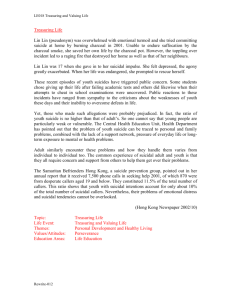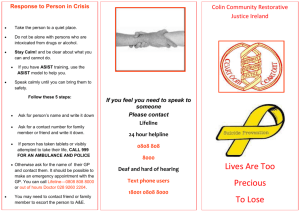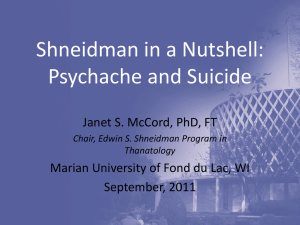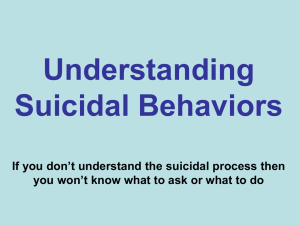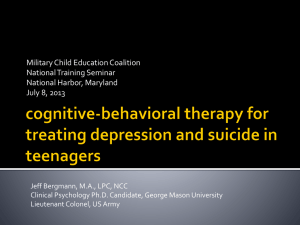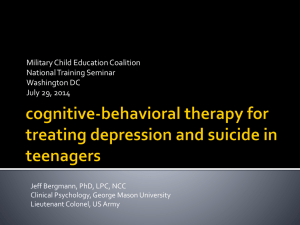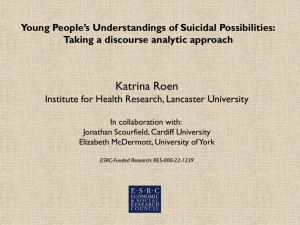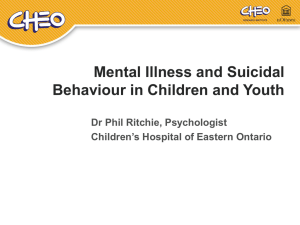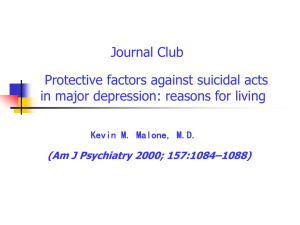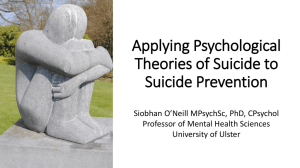Suicidal Theories
advertisement
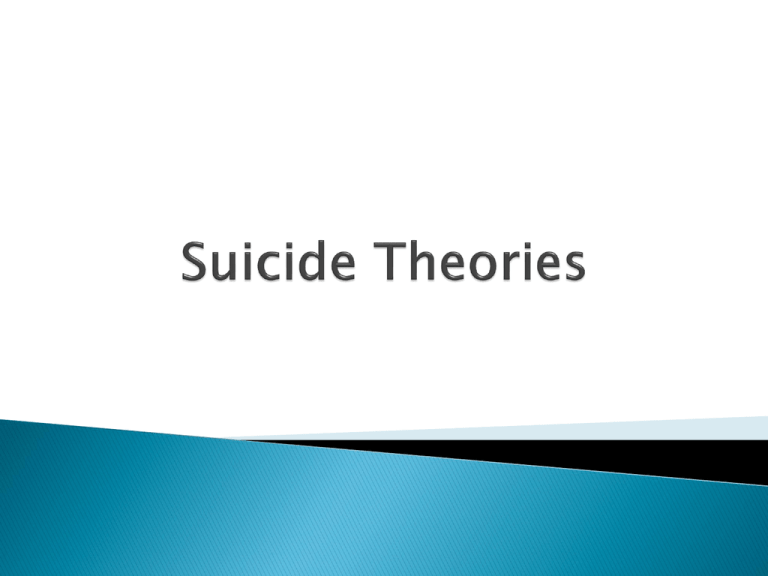
So why are theories important? 1) Guides research 2) Guides clinical work 3) Creates new hypotheses Joiner’s Interpersonal-Psychological Theory of Suicidal Behavior Those Who Desire to Die Thwarted Belongingness May endorse suicidal ideation Those who are capable of suicide Perceived Burdensomeness At greatest risk of suicide Van Orden, Witte, Gordon, Bender & Joiner, 2008 • • The interpersonal-psychological theory of suicidal behavior argues that, in order to enact lethal selfharm, an individual must habituate to physical pain and the fear of death. This process of habituation occurs through repeated exposure to painful and provocative events. • Examples of habituation? www.youtube.com/watch?v=Jrjf3V7Tc1c Emphasized collective social forces and dismissed most other factors Disturbed regulation of the individual by society Two basic types of regulation: 1) Social integration - Low integration = “egoistic” - when people feel like they don’t belong, purposeless and become desperate * Similar to Joiner’s concept of belongingness - High integration = “altruistic” – Excessive integration leads people to lose themselves and to commit to a larger goal * Similar to Joiner’s concept of burdernsomeness 2) Moral regulation - Low regulation = “anomic” - Sudden changes in the social position of an individual due to abrupt changes in society lead to a lack of social direction - High regulation = “fatalistic” – Occurs among people who live overregulated, unrewarding lives. Why was he so influential? 1) Emphasized social disconnection as a major source for one’s desire to end his/her life 2) Introduced the concept of perceived burdensomeness as a risk factor to serious suicidal behavior 3) There were very few theorists during this time - Sullivan Menninger Focused on the nature of psychological needs and the consequences of having those needs thwarted “Suicide is caused by a certain kind of psychological pain called “psychache”. ◦ Psychache is defined as a general psychological and emotional pain that reaches intolerable intensity. ◦ Risk factors operate by increasing psychache which predisposes one to suicidality. Psychache is compatible with Joiner’s concepts of perceived burdensomeness and failed belongingnes. Emphasized the role of hopelessness ◦ In one study Beck and colleagues correctly identified 91% of those who later died by suicide. ◦ Those with high hopelessness were 11 times more likely to die by suicide than those with lower scores. Joiner believes that hopelessness doesn’t tell the whole story and is not sufficient for suicidal behavior. ◦ Hopelessness about belongingness and burdensomeness is required, together with the acquired capability for serious self-harm Beck also argued that previous suicidal experience sensitizes suicide-related thoughts and behaviors so that they become more accessible and active. ◦ Allows for subsequent episodes to be more easily triggered and more severe ◦ Shares similarities with Joiner’s model which proposes an escalating course of suicidal behavior over time through habituation. Proposed an escaped theory of suicide Described a series of steps leading up to serious suicidal behavior: 1) Individual experiences a negative and severe discrepancy between expectations and actual events 2) An aversive state of high self-awareness develops, which produces negative affect * Person may dwell on personal inadequacies leading to distress, sadness, and worry. 3) Person attempts to escape from negative affect as well as from the aversive selfawareness by retreating into a numb state of cognitive deconstruction. * Person disregards meaningful thoughts about self and replaces them with lower-level more immediate goals and tasks. * Reduced inhibition results which leads to a lack of impulse control in general (particularly with respect to suicidal behavior). Fluid Vulnerability Model ◦ Suicidal episodes are time-limited. ◦ Risk factors that both trigger a suicidal episode and determine the duration and severity of an episode are fluid. ◦ Imminent risk cannot endure beyond periods of heightened arousal. ◦ Baseline risk varies from person to person. Fluid Vulnerability Model Acute Risk Suicidal Mode Acute Risk Baseline Risk Person 1 Baseline Risk Person 2 Adapted from Rudd, 2006
